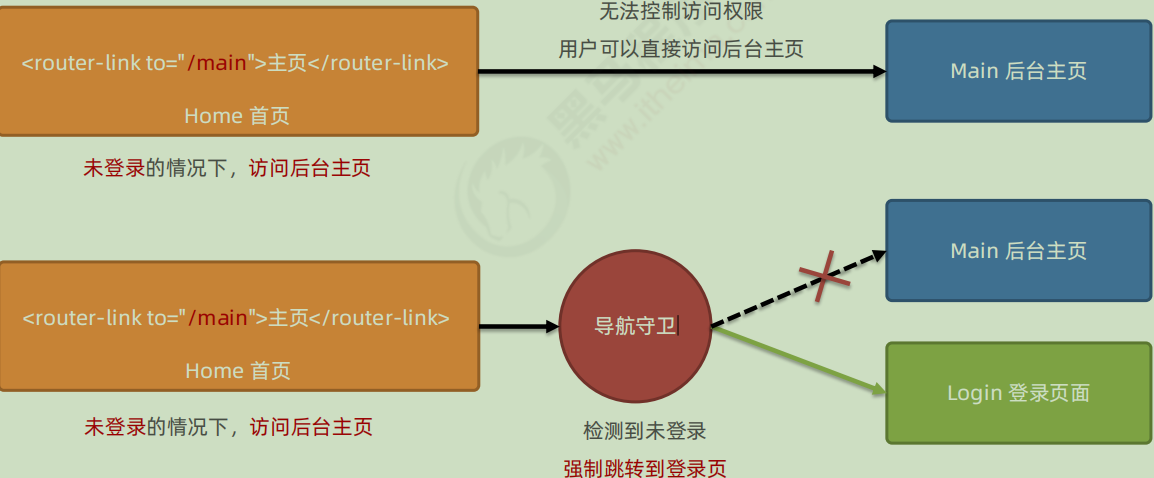前端路由的概念与原理
1.1什么是路由:对应关系,通俗易懂的话来讲就是Hash地址与组件的之间的对应关系
1.2前端路由的工作原理
- 用户点击了页面上的路由链接
- 导致了URL地址栏中的Hash值发生了变化
- 前端路由监听到了Hash值的变化
- 前端路由把当前的Hash地址对应的组件渲染到浏览器中

vue-router 的基本使用用法
1.1vue-router是vue.js官方给出的路由解决方案,只能结合vue使用能够管理SPA项目中组件的切换
1.2vue-router安装和配置步骤
1. 安装vue-router包命令如下:
npm i vue-router@3.5.2 -S
2.创建路由模块
//src/router/index.js当前项目的路由模块 //1导入vue和vueRouter的包 import Vue from "vue" import VueRouter from "vue-router" //2.调用vue.use()函数,把VueRouter安装为Vue的插件 Vue.use(VueRouter) //3.创建路由的实例对象 const router=new VueRouter() //4.向外共享路由的实例对象 export default router
3.导入并挂载路由模块
// 导入路由模块,目的:拿到路由的实例对象 // 在进行模块化导入的时候,如果给定的是文件夹,则默认导入这个文件夹下,名字叫做 index.js 的文件 import router from '@/router Vue.config.productionTip = false new Vue({ render: h => h(App), // 在 Vue 项目中,要想把路由用起来,必须把路由实例对象,通过下面的方式进行挂载 // router: 路由的实例对象 router }).$mount('#app')
4.声明路由链接和占位符
<router-link to="/movie/1">洛基</router-link>
<router-link to="/movie/2?name=zs&age=20">雷神</router-link>
<router-link to="/movie/3">复联</router-link>
<router-link to="/about">关于</router-link>
<hr />
<!-- 只要在项目中安装和配置了 vue-router,就可以使用 router-view 这个组件了 -->
<!-- 它的作用很单纯:占位符 -->
<router-view></router-view>
1.3在 src/router/index.js 路由模块中,通过 routes 数组声明路由的匹配规则。示例代码如下
//1导入vue和vueRouter的包 import Vue from "vue" import VueRouter from "vue-router" import Home from '@/components/Home.vue' import Movie from '@/components/Movie.vue' import About from '@/components/About.vue' //2.调用vue.use()函数,把VueRouter安装为Vue的插件 Vue.use(VueRouter) //3.创建路由的实例对象 const router = new VueRouter({ //routes是一个数组,定义hash地址与组件的对应关系 routes: [ { path: '/home', component: Home }, { path: '/movie', component: Movie }, { path: '/about', component: About } ] }) //4.向外共享路由的实例对象 export default router
vue-router 的常见用法
1.1路由重定向:用户再放访问A地址的时候,强制用户跳转到C地址,从而展示特定的组件页面通过路由规则的redirect属性指定一个新的路由地址,设置路由的重定向
//3.创建路由的实例对象
const router = new VueRouter({
//routes是一个数组,定义hash地址与组件的对应关系
routes: [
//重定向路由规则
{ path: '/', redirect: '/home' },
//路由规则
{ path: '/home', component: Home },
{ path: '/movie', component: Movie },
{ path: '/about', component: About }
]
})
1.3嵌套路由:通过路由实现组件的嵌套展示
<!-- 子级路由链接 --> <router-link to="/about/tab1">tab1</router-link> <router-link to="/about/tab2">tab2</router-link> <hr /> <!-- 子级占位符 --> <router-view></router-view>
2通过 children 属性声明子路由规则
import Tab1 from '@/components/tabs/Tab1.vue'
import Tab2 from '@/components/tabs/Tab2.vue'
//2.调用vue.use()函数,把VueRouter安装为Vue的插件
Vue.use(VueRouter)
//3.创建路由的实例对象
const router = new VueRouter({
//routes是一个数组,定义hash地址与组件的对应关系
routes: [
//重定向路由规则
{ path: '/', redirect: '/home' },
//路由规则
{ path: '/home', component: Home },
{ path: '/movie', component: Movie },
{
path: '/about', component: About, redirect: '/about/tab1', children: [
// 子路由规则,只要在子路由节点下path中不必加/
{ path: 'tab1', component: Tab1 },
{ path: 'tab2', component: Tab2 }
]
}
]
})
1.4动态路由匹配:是把Hash地址中可变的部分定义为参数项,从而提高了路由规则的复用性。在vue-router中使用英文(:)来定义路由的参数项
routes: [
//重定向路由规则
{ path: '/', redirect: '/home' },
//路由规则
{ path: '/home', component: Home },
//在vue-router中使用英文(:)来定义路由的参数项
{ path: '/movie/:id', component: Movie }
}
]
1.4.1在动态路由渲染出来的组件中,可以使用this.$route.parans对象访问到动态匹配的参数值
<template> <div class="movie-container">
//this.$route.params是路由的参数对象
<h3>Movie 组件---{{this.$route.params.id}} </h3> <button @click="showThis">打印this</button> </div> </template>
1.4.2使用 props 接收路由参数,为了简化路由参数的获取形式,vue-router 允许在路由规则中开启 props 传参。示例代码如下
// 可以为路由规则开启props传参,从而可以拿到动态参数的值 { path: '/movie/:id', component: Movie, props: true }, <template> <div class="movie-container"> <h3>Movie 组件---{{id}} </h3> <button @click="showThis">打印this</button> </div> </template> <script> export default { name: 'Movie', //接受props数据 props: ['id'] } </script>
1.5声明式导航和编程式导航
1.5.1声明式导航:在浏览器中点击链接实现导航的方式,叫做声明式导航,例如网页中点击<a>标签链接、vue中点击<router-link>都属于声明式导航
1.5.2编程式导航:在浏览器中调用API方法实现导航的方式叫做编程式导航,例如网页中调用localtion.href跳转到新页面的方式属于编程式导航
1.5.3vue-router 中的编程式导航 API
1.5.3.1this.$router.push('hash地址'):跳转到指定的hash地址,并增加一条记录
<template> <div class="home-container"> <h3>Home 组件</h3> <hr /> <button @click="gotopush"> 通过push跳转到“洛基”页面</button> </div> </template> <script> export default { name: 'Home', methods: { gotopush() { //通过编程式API,导航跳转到的指定页面 this.$router.push('/movie/1') } } } </script>
1.5.3.2this.$router.replace('hash 地址'):跳转到指定的 hash 地址,并替换掉当前的历史记录
<template> <div class="home-container"> <h3>Home 组件</h3> <hr /> <button @click="gotoreplace">通过replace跳转到“洛基”页面</button> </div> </template> <script> export default { name: 'Home', methods: { gotoreplace() { this.$router.replace('/movie/1') } } } </script>
1.5.3.3this.$router.go(数值 n):调用$router.go()方法,可以在浏览器历史中前进和后退
<template> <div class="movie-container"> <h3>Movie 组件---{{this.$route.params.id}}-----{{id}} </h3> <button @click="showThis">打印this</button> <button @click="goback">后退</button> <!-- $router.go 的简化用法 --> <!-- $router.back()在历史记录中,后退到上一个页面 --> <button @click="$router.back()">back后退</button> <!-- $router.forward()在历史记录中,前进到下一个页面 --> <button @click="$router.forward()">forward前进</button> </div> </template> <script> export default { name: 'Movie', methods: { showThis() { console.log() }, //go(-1)表示后退一层 //如果后退次数上限则原地不动 goback() { this.$router.go(-1) } }, } </script>
1.6导航守卫:导航守卫可以控制路由的访问权限

1.6.1全局前置守卫:每次发生路由的导航跳转时,都会触发到前置守卫,因此可以对每一个路由进行访问权限的控制
//为router实例对象声明全局前置导航守卫
//只要发生了路由跳转,必然会触发beforeEach指定的function回调函数
router.beforeEach(function (to, from, next) {
//to表示将要访问的路由信息对象
//from表示将要离开的路由的信息对象
//next表示放行的意思
next()
})
1.6控制后台主页的访问权限
//为router实例对象声明全局前置导航守卫
//只要发生了路由跳转,必然会触发beforeEach指定的function回调函数
router.beforeEach(function (to, from, next) {
//to表示将要访问的路由信息对象
//from表示将要离开的路由的信息对象
//next表示放行的意思
//分析:
//1.要拿到用户访问的hash地址
//2.判断hash地址是否等于/main
//如果等于/main则需要登入之后才能访问
//如果不等于,则不需要登入直接调用next()放行
//3如果访问的地址是/main则需要读取localStorage中的token值
// 如果有token值则放行
// 没有则强制跳转到login登录页面
if (to.path === '/main') {
//要访问的后台主页需要判断是否有token
const token = localStorage.getItem('token')
if (token) {
next()
} else {
//没有登入强制跳转到登入页面
next('/login')
}
} else {
next()
}
})







 浙公网安备 33010602011771号
浙公网安备 33010602011771号